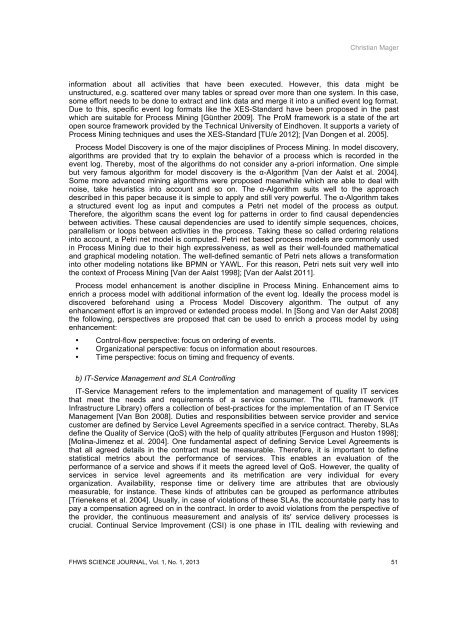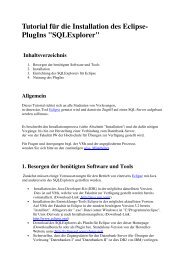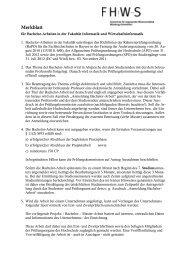FHWS Science Journal - Fakultät Informatik und Wirtschaftsinformatik
FHWS Science Journal - Fakultät Informatik und Wirtschaftsinformatik
FHWS Science Journal - Fakultät Informatik und Wirtschaftsinformatik
Create successful ePaper yourself
Turn your PDF publications into a flip-book with our unique Google optimized e-Paper software.
Christian Mager<br />
information about all activities that have been executed. However, this data might be<br />
unstructured, e.g. scattered over many tables or spread over more than one system. In this case,<br />
some effort needs to be done to extract and link data and merge it into a unified event log format.<br />
Due to this, specific event log formats like the XES-Standard have been proposed in the past<br />
which are suitable for Process Mining [Günther 2009]. The ProM framework is a state of the art<br />
open source framework provided by the Technical University of Eindhoven. It supports a variety of<br />
Process Mining techniques and uses the XES-Standard [TU/e 2012]; [Van Dongen et al. 2005].<br />
Process Model Discovery is one of the major disciplines of Process Mining. In model discovery,<br />
algorithms are provided that try to explain the behavior of a process which is recorded in the<br />
event log. Thereby, most of the algorithms do not consider any a-priori information. One simple<br />
but very famous algorithm for model discovery is the α-Algorithm [Van der Aalst et al. 2004].<br />
Some more advanced mining algorithms were proposed meanwhile which are able to deal with<br />
noise, take heuristics into account and so on. The α-Algorithm suits well to the approach<br />
described in this paper because it is simple to apply and still very powerful. The α-Algorithm takes<br />
a structured event log as input and computes a Petri net model of the process as output.<br />
Therefore, the algorithm scans the event log for patterns in order to find causal dependencies<br />
between activities. These causal dependencies are used to identify simple sequences, choices,<br />
parallelism or loops between activities in the process. Taking these so called ordering relations<br />
into account, a Petri net model is computed. Petri net based process models are commonly used<br />
in Process Mining due to their high expressiveness, as well as their well-fo<strong>und</strong>ed mathematical<br />
and graphical modeling notation. The well-defined semantic of Petri nets allows a transformation<br />
into other modeling notations like BPMN or YAWL. For this reason, Petri nets suit very well into<br />
the context of Process Mining [Van der Aalst 1998]; [Van der Aalst 2011].<br />
Process model enhancement is another discipline in Process Mining. Enhancement aims to<br />
enrich a process model with additional information of the event log. Ideally the process model is<br />
discovered beforehand using a Process Model Discovery algorithm. The output of any<br />
enhancement effort is an improved or extended process model. In [Song and Van der Aalst 2008]<br />
the following, perspectives are proposed that can be used to enrich a process model by using<br />
enhancement:<br />
• Control-flow perspective: focus on ordering of events.<br />
• Organizational perspective: focus on information about resources.<br />
• Time perspective: focus on timing and frequency of events.<br />
b) IT-Service Management and SLA Controlling<br />
IT-Service Management refers to the implementation and management of quality IT services<br />
that meet the needs and requirements of a service consumer. The ITIL framework (IT<br />
Infrastructure Library) offers a collection of best-practices for the implementation of an IT Service<br />
Management [Van Bon 2008]. Duties and responsibilities between service provider and service<br />
customer are defined by Service Level Agreements specified in a service contract. Thereby, SLAs<br />
define the Quality of Service (QoS) with the help of quality attributes [Ferguson and Huston 1998];<br />
[Molina-Jimenez et al. 2004]. One f<strong>und</strong>amental aspect of defining Service Level Agreements is<br />
that all agreed details in the contract must be measurable. Therefore, it is important to define<br />
statistical metrics about the performance of services. This enables an evaluation of the<br />
performance of a service and shows if it meets the agreed level of QoS. However, the quality of<br />
services in service level agreements and its metrification are very individual for every<br />
organization. Availability, response time or delivery time are attributes that are obviously<br />
measurable, for instance. These kinds of attributes can be grouped as performance attributes<br />
[Trienekens et al. 2004]. Usually, in case of violations of these SLAs, the accountable party has to<br />
pay a compensation agreed on in the contract. In order to avoid violations from the perspective of<br />
the provider, the continuous measurement and analysis of its' service delivery processes is<br />
crucial. Continual Service Improvement (CSI) is one phase in ITIL dealing with reviewing and<br />
<strong>FHWS</strong> SCIENCE JOURNAL, Vol. 1, No. 1, 2013 51








